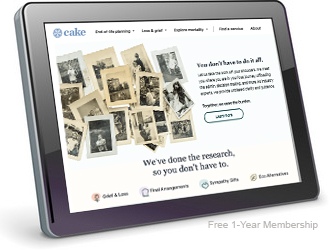Death announcements serve a vital function in notifying the community about the loss of a loved one. These notices convey information about the deceased and provide details about the funeral services, enabling friends, family, and acquaintances to offer their condolences and support. Death announcements have shifted from traditional printed notices to contemporary digital platforms, reflecting changes in how we communicate and share information.
To ensure you are managing all the details when planning for a funeral, the Overnight Caskets’ funeral experts prepared three helpful post-loss checklists.
Step 1 - Immediate Arrangements
Step 2 - Disposition planning
Step 3 - Funeral Planning
Now, let’s look at traditional and modern ways families announce a death.
---------------------------------
Traditional Death Announcements
Definition and Purpose
Traditional death announcements are formal notices that inform the community about someone's passing. They are usually brief and straightforward, focusing on essential details. The main purposes of these announcements are to notify the community, provide funeral details, and honor the deceased. You can find traditional death announcements in newspapers, community boards, and funeral home publications.
Common Elements and Structure
Traditional death announcements generally follow a specific structure, including:
- Full Name: The full name of the deceased.
- Date of Death: The exact date the person passed away.
- Basic Information: Optional details such as date of birth or age at the time of death.
- Location of Death: Where the person died, if desired.
- Funeral/Memorial Service Details: Essential information about the service's date, time, and location.
- Donation Information: Instructions for memorial donations, if applicable.
Examples of Traditional Phrasing
Here are some examples of typical phrases used in traditional death announcements:
"The Smith family announces with sorrow the passing of John Smith on January 10, 2023. A memorial service will be held on January 15 at St. Mark's Church."
"It is with deep regret that we inform you of the death of Mary Johnson, who passed away on February 5, 2023. Funeral services will be held at Green Hill Cemetery on February 10 at 2:00 PM."
Publication Methods

Traditional death announcements are commonly published in the following ways:
- Newspapers: Local or regional newspapers are a traditional medium for death announcements. They provide a broad reach within the community (Sympathy Message Ideas).
- Community Boards: Notices may be placed in local community centers, churches, or other places of worship.
- Town Criers: Young men would crisscross the town ranging a bell or blowing a horn to gain attention for the day’s news, which they yelled at the top of their lungs
Cultural and Regional Variations
Different cultures and regions have unique practices and customs regarding death announcements. For example, some communities may include religious references or traditional expressions of mourning. In some cultures, it is customary to mention the deceased's lineage or titles.
Paid mourners may seem strange to some, but it is an ancient tradition found in many societies. The practice of having paid mourners is believed to have begun in China and the Middle East and was also found in ancient Egypt and Rome. Families of wealthy or well-known Romans competed to hold the most extravagant funerals. They would hire hundreds of unrelated professional mourners to walk in the funeral procession. The mourners were compensated for the quality of their crying and wailing. Families gave bonuses to mourners who went the extra mile by ripping out their hair, tearing their clothes, and scratching their faces.
Etiquette and Guidelines
When writing a traditional death announcement, it is important to:
- Be concise and clear.
- Proofread to avoid errors.
- Respect the family's wishes regarding the sharing of sensitive information like the cause of death.
- Ensure all necessary details are accurate before publication (Legacy.com) (Urns Online).
---------------------------------
Modern Death Announcements
Definition and Purpose
Modern death announcements have evolved to accommodate new technologies and social media platforms, providing a more adaptable and personalized method for informing others of a death. While they fulfill the basic purposes of traditional announcements, modern death announcements allow for greater creativity and customization. They can be easily and widely shared, making them a practical choice in today's digital age.
Common Elements and Structure
Modern death announcements typically include:
- Full Name and Date of Death: Essential elements that remain unchanged.
- Personal Messages: Often include more personal notes or memories.
- Photos and Videos: Commonly included in digital announcements.
- Interactive Elements: Links to online memorials, donation pages, or virtual guestbooks.
Examples of Contemporary Phrasing
Examples of modern death announcement phrasing include:
"With heavy hearts, we announce the passing of John Doe on January 10, 2023. John brought joy to many lives and will be deeply missed. Please join us for a memorial service on January 15 at St. Mark's Church."
"We are saddened to share that Mary Johnson has passed away. Her life will be celebrated at Green Hill Cemetery on February 10 at 2:00 PM. In lieu of flowers, please consider a donation to the American Heart Association."
Publication Methods

Modern death announcements can be published through various methods:
- End-of-Life Platforms: Websites dedicated to memorials or funeral announcements, such as Cake, Legacy.com, or Ever Loved.
- Social Media: Platforms like Facebook, Instagram, and Twitter allow for quick and broad dissemination of death announcements (Sympathy Message Ideas) (Smilebox).
- Funeral Home Websites: Many funeral homes include death announcements on their websites as part of their services.
- Emails and Text Messages: Direct communication to friends and family via email or text messages is also common.
Technological Influences and Innovations
Modern death announcements benefit from several technological advancements:
- Interactive Memorial Pages:These pages allow visitors to leave messages, share photos, and make donations in memory of the deceased.
- Digital Invitations: Easy distribution of service details and RSVP tracking through digital means.
- Livestream Services: Allow remote attendance at memorial services, accommodating those who cannot be present in person.
Cultural and Regional Variations
Modern announcements can be customized to fit cultural preferences and regional practices. For example, digital announcements can incorporate traditional symbols or language relevant to the deceased's cultural background. This flexibility allows for a more inclusive approach to sharing the news of a loved one's passing.
Etiquette and Guidelines
When creating a modern death announcement, consider the following:
- Respect Privacy: Consider the deceased’s and the family’s privacy. Use privacy settings on social media to control the announcement's visibility.
- Confirm Details: Ensure all information is accurate before sharing to avoid misinformation.
- Consult Family: Work within a group and consult with central family members to avoid miscommunication about sensitive details.
Traditional and modern death announcements play a crucial role in honoring a loved one and informing the community of their passing. While older methods offer a formal and structured approach, modern announcements provide flexibility and personalization, utilizing digital platforms to reach a wider audience. Understanding the differences between these approaches can help families choose the best method to honor their loved one’s memory while effectively communicating all necessary details.
Selecting the appropriate method for a death announcement depends on several factors, including the family's preferences, cultural considerations, and the desired reach of the announcement. By incorporating elements of both traditional and modern approaches, families can create a meaningful and respectful tribute to their loved ones.

